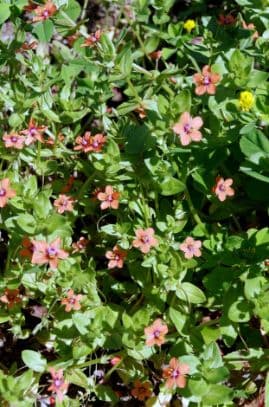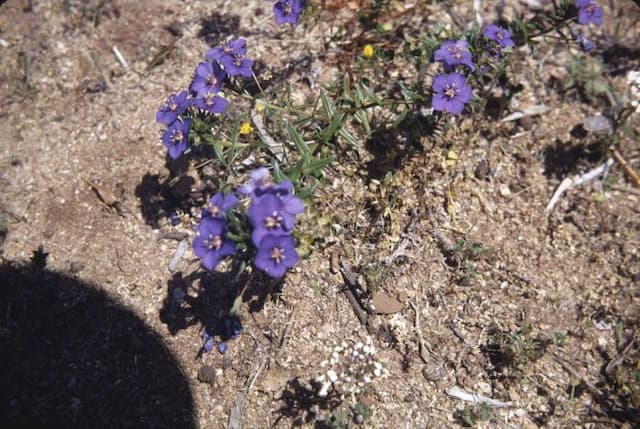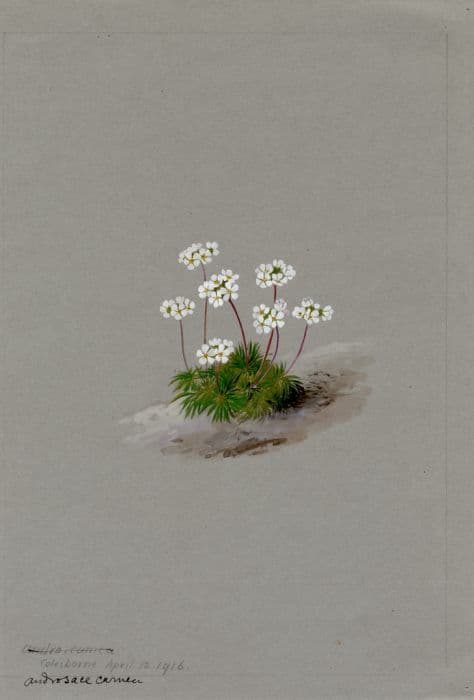Primrose Primula 'Tantallon' (Pe)

ABOUT
The Primula 'Tantallon' is a captivating plant, notable for its vivid and charming blooms. A standout feature is the clusters of flowers that it produces, which are typically in a vibrant hue. The petals of these flowers are shaped in a way that forms a lovely rosette pattern, giving it a very ornate and appealing look. The center of each flower often displays a contrasting color, creating an eye-catching effect that makes the plant even more attractive. The flowers emerge from a rosette of leaves at the base of the plant. These leaves are generally lush and may have a texture that can be described as either crinkly or smooth, depending on the specific variety of Primula 'Tantallon'. The foliage itself presents in a rich green color, forming an elegant backdrop for the bright flowers. In terms of its growth habit, Primula 'Tantallon' tends to have a compact form, making it an ideal choice for gardeners who wish to add a splash of color to containers or borders without overwhelming the space. Despite omitting the specifics of its size, the overall appearance of the plant can be summed up as charmingly delicate yet capable of making a striking impact due to its beautiful blossoms and lush foliage.
About this plant
 Names
NamesSynonyms
Tantallon Primrose, Scotch Primrose.
Common names
Primula 'Tantallon' Pe
 Toxicity
ToxicityTo humans
Primula 'Tantallon' (Pe), commonly known as Primrose, is generally considered to be non-toxic to humans. However, eating parts of any plant can potentially cause reactions in some individuals. If ingested in large quantities, it may cause mild stomach upset. Most people should not experience any severe toxicity from touching or ingesting the primrose.
To pets
Primrose is generally considered to be non-toxic to pets as well. Like with humans, consumption of plant parts in large amounts could cause mild gastrointestinal upset in some pets, such as vomiting or diarrhea. However, it is not expected to cause serious illness or death from toxicity. As always, it is best practice to keep houseplants out of reach of pets to prevent any potential issues.
 Characteristics
CharacteristicsLife cycle
Perennials
Foliage type
Evergreen
Color of leaves
Green
Flower color
Varies
Height
6 inches (15 cm)
Spread
12 inches (30 cm)
Plant type
Herb
Hardiness zones
5
Native area
Europe
Benefits
 General Benefits
General Benefits- Attracts Pollinators: Primula 'Tantallon' helps support local ecosystems by attracting bees, butterflies, and other essential pollinators to the garden.
- Low Maintenance: Once established, this perennial requires minimal care, making it ideal for gardeners who prefer plants that do not need constant attention.
- Colorful Blooms: With its vibrant and colorful flowers, it adds a splash of color to gardens during its blooming season, helping to uplift the mood and enhance the beauty of the space.
- Herbaceous Border: This plant is excellent for planting in a herbaceous border, creating a tapestry of varied colors and textures along with other perennials.
- Container Gardening: Suitable for pots and containers, Primula 'Tantallon' can brighten up patios, balconies, or small gardens where ground space is limited.
- Ground Cover: They can be used as an effective ground cover, filling in gaps and reducing the growth of weeds by covering bare soil.
 Medical Properties
Medical PropertiesThis plant is not used for medical purposes.
 Air-purifying Qualities
Air-purifying QualitiesThis plant is not specifically known for air purifying qualities.
 Other Uses
Other Uses- Edible Decorations: The flowers of the Primula can be crystallized with egg white and sugar to serve as an attractive edible garnish for desserts and cakes.
- Scented Potpourri: Dried Primula flowers can be added to potpourri mixes to contribute a pleasant fragrance to your home.
- Natural Dyes: The petals of the Primula can be used to produce a range of natural dyes for coloring fabrics or other materials.
- Photography Subjects: With their vibrant colors and interesting shapes, Primula flowers are a great subject for amateur and professional photographers alike.
- Art Inspiration: Artists can use the unique beauty of the Primula as inspiration for paintings, drawings, and other forms of art.
- Teaching Tool: Primula plants can be used to help educate about plant life cycles, pollination, and horticulture in classrooms or workshops.
- Pollinator Support: Planting Primula in your garden can attract and support bees, butterflies, and other important pollinators in the ecosystem.
- Fairy Gardens: The Primula is a perfect addition to whimsical fairy or miniature gardens due to their small size and bright colors.
- Greeting Cards: Pressed Primula flowers can be mounted onto handmade greeting cards for a personal touch.
- Jewelry Making: The blooms can be incorporated into clear resin to create unique pieces of jewelry like pendants and earrings.
Interesting Facts
 Feng Shui
Feng ShuiThe Primula is not used in Feng Shui practice.
 Zodiac Sign Compitability
Zodiac Sign CompitabilityThe Primula is not used in astrology practice.
 Plant Symbolism
Plant Symbolism- Hope: The primrose, including 'Tantallon', symbolizes hope as it is one of the first flowers to bloom in the spring, signaling the end of winter and the arrival of warmer days.
- Youth: The fresh and vibrant appearance of the primrose represents youthfulness and the joy of life.
- Renewal: The primrose's early spring appearance makes it a symbol of new beginnings and the rebirth of nature.
- Love and Affection: In the language of flowers, gifting primroses can indicate a message of care and affection towards someone.
 Water
WaterPrimroses, including the Primula 'Tantallon', enjoy consistently moist soil, so watering them thoroughly once a week should suffice. Adjust this frequency to maintain moisture during hotter periods or in drier climates, potentially increasing to two to three times a week. When watering, aim for about one gallon of water per plant, ensuring it reaches the roots without oversaturating the soil. Avoid getting water on the leaves to prevent fungal diseases. During winter, reduce watering as the plant goes dormant and requires less moisture.
 Light
LightPrimula 'Tantallon' thrives in partial shade, making it an excellent choice for a spot that receives filtered sunlight. The ideal location would provide morning light with protection from harsh afternoon sun, which can scorch the leaves. Bright, indirect light is key to supporting abundant blooms and healthy foliage growth.
 Temperature
TemperatureThe ideal temperature range for Primula 'Tantallon' is between 50°F and 70°F. They can tolerate a minimum temperature of 30°F but should be protected from frost. It's important to avoid high heat, so during the summer months, especially if temperatures rise above 80°F, extra care should be taken to keep the plants cool, such as providing shade or using mulch to maintain cooler soil.
 Pruning
PruningPrimrose plants, including 'Tantallon', benefit from deadheading spent flowers to encourage further blooming and maintain a tidy appearance. Pruning should be done as flowers fade, using clean, sharp shears. Additionally, remove any damaged or yellowing leaves to prevent disease and pests. The best time for a more thorough prune is after the blooming season is over.
 Cleaning
CleaningAs needed
 Soil
SoilFor Polly Primrose (Primula 'Tantallon'), a rich, well-draining soil mix is crucial; a mixture composed of peat, loam, and sand in equal parts facilitates healthy growth. Maintain soil pH between 6.0 and 7.0 for optimal conditions.
 Repotting
RepottingPolly Primrose should be repotted every 1-2 years to replenish the nutrients in the soil and provide space for growth. It's best to repot in the spring just before the growing season begins.
 Humidity & Misting
Humidity & MistingPolly Primrose thrives in conditions with high humidity, generally around 75-85%. It is important to maintain consistent humidity levels to keep these plants healthy and encourage flowering.
 Suitable locations
Suitable locationsIndoor
Place in bright, indirect light with high humidity.
Outdoor
Position in partial shade, sheltered from wind and hot sun.
Hardiness zone
4-8 USDA
 Life cycle
Life cyclePrimula 'Tantallon', commonly known as primrose, begins its life cycle with seed germination, typically in the spring, where the seed must be exposed to light to successfully sprout. The seedling then develops into a rosette of leaves at the soil surface, establishing a root system to absorb nutrients and water. As the plant matures, it produces distinctive flowers, which vary in color, generally in the early spring following a period of winter chill, a process that is crucial for vernalization and subsequent flowering. After pollination, often by insects, the flowers will produce capsules containing tiny seeds that are eventually dispersed by wind or other means. The plant often enters a period of dormancy during the late fall and winter, conserving energy for the next growing season. Over the years, clumps of these perennials can be divided and replanted to propagate new plants and maintain vigorous growth.
 Propogation
PropogationPropogation time
Spring-summer
The most popular method of propagation for Primula 'Tantallon', commonly known as Primrose, is by division. The ideal time for dividing Primrose plants is just after they have finished flowering in late spring to early summer. To propagate by division, carefully lift the plant from the ground, ensuring minimal disturbance to the root ball. Using a clean, sharp tool, separate the plant into smaller sections, making sure each section has a healthy portion of roots attached. Replant each section at the same depth it was growing at previously, spacing them about 6 to 12 inches (15 to 30 centimeters) apart to allow for enough room to grow. Water the newly planted divisions thoroughly to help establish them. Dividing Primrose not only helps propagate new plants but also rejuvenates older clumps that may have become crowded or less vigorous.









